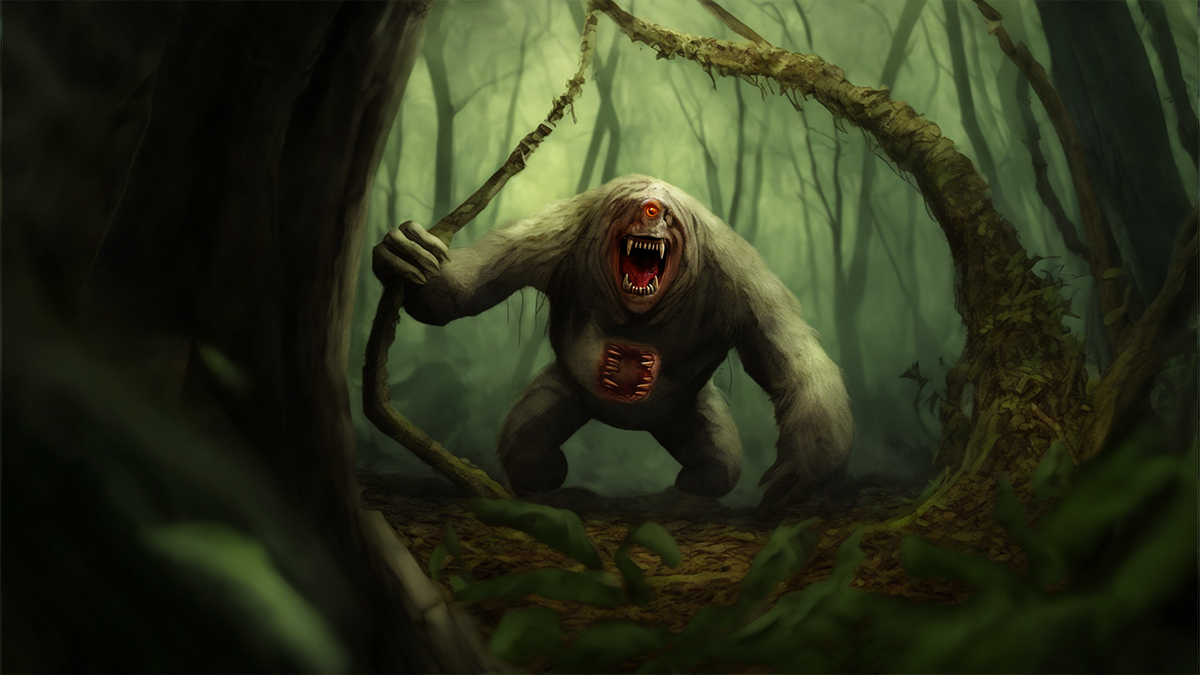The Mapinguari is a legendary ground-dwelling sloth-like creature resembling an ape which is reported to still roam the jungles of Brazil and Bolivia.
Description
The Mapinguari is thought to be a relative of a type of giant ground sloth (possibly a Megatherium) that is generally believed to have died out some 10,000 years ago. However, some think these sloths may have survived and could be living in the jungles of South America.
These sandy-haired beasts first appeared over 30 million years ago, and fossil records reveal they inhabited North and South America, the Caribbean, and Antarctica.
The sloths weighed approximately 500 pounds and stood 9 feet tall on their hind legs. This big marsupial was a quadruped, with long claws that curled back under its feet and faced backward when it walked.
It is thought that these sloths may have been raised for food in the same way cattle are today.
“Mapinguari” translates to “roaring animal” or “fetid beast.”
The Mapinguaris of local folklore have some disturbing characteristics (possibly exaggerated over the years as the legend grew), including having only one eye (it sometimes has two eyes) and a second mouth on their stomachs.
The Mapinguaris’s second mouth is huge and has four large canine-type teeth. The creature’s color ranges from brown to black to grey.
Local stories also describe the beast as being slow-moving but ferocious and able to move through the vegetation without making a sound.
Its smell is putrid, and its skin is seemingly impervious to arrows and bullets. The beast was both bipedal and could walk on all fours. When standing, it can reach up to a massive height, between six and 10 meters or 20 to 30 feet.
The legendary Mapinguari’s only known weakness is its aversion to water. It is thought that it cannot move very easily in water, so it tends to avoid it whenever possible.
Another feature of the Mapinguari is that it is believed to be a herbivore most of the time but will also eat flesh. They tend to attack cattle, killing them by ripping off their limbs and their tongues with their sharp claws. They will attack humans if they feel their habitat is threatened.
Other descriptors include long, powerful arms that could tear down a palm tree and thick, matted fur. The creature is also said to emit a terrifying shriek.
The Mapinguari seems to look like Bigfoot but retains certain sloth-like features. This leads scientists to believe that, if the creature does exist, it is probably some form of a giant sloth.
The name, Mapinguari, is thought to have originated from one of the languages native to the Amazon region and loosely translates to “A thing with the twisted feet” or “That who has twisted feet.”
Sightings and Tales
The myth is thought to have first become known in the late 19th century and coincided with the rubber cycle in the Amazon rain forest. The legend first spread among the rubber tappers, who extract the rubber from trees.
One of the most reliable early sightings was made by Ramón Lista in the late 19th century. While riding in Santa Cruz, he saw a shaggy red-haired creature run across the road ahead of him.
He shot at the animal and was amazed that the bullets bounced off its skin.
In 1975, a miner named Mário Pereira de Souza claimed he saw a Mapinguari at a mining camp along the Rio Jamauchím south of Itaituba, Pará State, Brazil.
He says he heard a scream and turned to see a huge creature advancing toward him on its hind legs. He remembers the creature’s awful stench.
A group of Kanamarí Indians in the Rio Juruá Valley state that they raised two Mapinguaris on bananas and milk. They say they released the creatures after about two years because their stench had become too much to bear. No one seems to know what happened to these Mapinguaris.
In 1994, biologist David Oren spoke to The New York Times about the fact that Amazonians were reporting sightings of Mapinguaris. He organized a trip to the Amazon; however, this expedition failed to uncover any evidence.
This lack of evidence meant that the scientific community had no cause to revise their opinion that the Mapinguari was extinct.
Discover Magazine ran a story about a Brazilian man who had supposedly encountered a Mapinguari. Manuel Vitorino Pinheiro dos Santos, an experienced hunter, heard a blood-curdling scream while moving through the Amazon. Hiding in a river, Manuel heard the scream a further four times as the creature slowly moved away.
| Other Name/s | Mapinguary, Mapi, Isnashi |
| Location | Bolivia, Brazil, |
| Type | Humanoid, Monster |
| Habitat | Jungle |
References
unknownexplorers.com, “Mapinguari,” accessed October 10, 2017,
cryptidchronicles.tumblr.com, “Untitled,” accessed October 10, 2017,
thecryptozoologist.webs.com, “MAPINGUARI: LEGENDARY MAN-EATING CRYPTID OF THE AMAZON RAINFOREST – PART 1”, accessed October 10, 2017,
phantomsandmonsters.com, “Mapinguari & Giant Sloth Sightings,” accessed October 10, 2017,
exemplore.com, “Mapinguari Sightings: Evidence the Giant Ground Sloth is Still Alive?” accessed October 10, 2017,
listverse.com, “10 Bizarre Prehistoric Cryptid Sightings,” accessed October 10, 2017,
patagoniamonsters.blogspot.co.uk, “Mapinguari the Amazonian mylodon,” accessed October 10, 2017.
